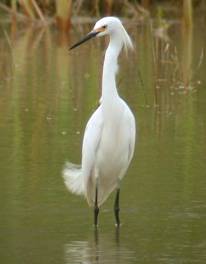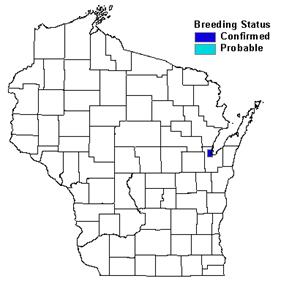Photo by Dennis Malueg


Status/Protection
- Global Rank: G5 Key to global and state ranks
- State Rank: S1B
- WBCI Priority: SGCN, State Endangered
Population Information
The Federal BBS information can be obtained at http://www.mbr-pwrc.usgs.gov/bbs/bbs.html by clicking on Trend Estimates and selecting the species in question. All estimates are for time period (1966-2005).
- Federal Breeding Bird Survey: significant increase
- Federal Breeding Bird Survey (WI): N/A
- Federal Breeding Bird Survey (BCR 23): N/A
- Federal Breeding Bird Survey (BCR 12): non-significant increase
- WSO Checklist Project: N/A
Life History
- Breeding Range: Scattered inland and coastal locations throughout the U.S., Mexico, and Central and South America (Parsons and Master 2000).
- Breeding Habitat: Bottomland Hardwood as well as inland lakes and rivers, freshwater swamps, barrier and dredge spoil islands (Parsons and Master 2000).
- Nest: Platform of sticks placed in a variety of trees and shrubs (Ehrlich et al. 1988).
- Nesting Dates: Eggs: mid-June to early July (Robbins 1991).
- Foraging: Stalk and strike (Ehrlich et al. 1988).
- Migrant Status: Short-distance migrant, Neotropical migrant.
- Habitat use during Migration: Emergent Marsh, Northern Sedge Meadow and Marsh, Southern Sedge Meadow and Marsh.
- Arrival Dates: Late April to late May (Robbins 1991).
- Departure Dates: Mid-July to mid-September (Robbins 1991).
- Winter Range: States along the southeastern and Gulf coasts; West Indies, Caribbean, coastal areas of Central and South America (DeGraaf and Rappole 1995, Parsons and Master 2000).
- Winter Habitat: Mangroves, coastal wetlands, swamps, ponds, rice fields, wet meadows (Parsons and Master 2000).
Habitat Selection
Throughout its range, the Snowy Egret uses a variety of wetland habitats for foraging, including freshwater marshes, swamps, flooded fields, tidal marshes, and mangroves. It is a colonial nester and frequently nests within mixed species colonies on island, mainland, and peninsular sites. Island sites are generally preferred as they afford more protection from human and predator disturbance (Parsons and Master 2000). In Wisconsin, all nesting records have been confined to marshes within Oconto and Brown counties and in association with Black-crowned Night-Heron colonies (Robbins 1991). Wetland habitats of several types attract post-breeding wandering and spring migrant Snowy Egrets across Wisconsin, including open marshes, sedge meadows, and floodplain forests.
Habitat Availability
Although there are Wisconsin breeding records for Snowy Egret, the state is not within its core breeding range or migratory route (Parsons and Master 2000). The widespread loss of floodplain forests has reduced the amount of suitable nest sites in the state for this and other colonial nesting waterbirds, such as Great Egret and Black-crowned Night-Heron. The loss and degradation of wetland ecosystems within the state also impacts this species by reducing the quality and quantity of feeding sites.
Population Concerns
The Snowy Egret has always been a rare species in Wisconsin (Robbins 1991) and will likely remain so because the state is not within its core distribution. Snowy Egret populations experienced similar precipitous declines as other herons during the plume hunting era but also recovered after regulatory protection. Today, populations appear to be increasing range-wide (Sauer et al. 2005), although there is much regional fluctuation (Parsons and Master 2000). Due to the rarity of Snowy Egret in Wisconsin, it is not adequately monitored by either the Breeding Bird Survey or the Wisconsin Checklist Project (Rolley 2005, Sauer et al. 2005). During the six seasons of the Wisconsin Breeding Bird Atlas (1995-2000), observers recorded one colony of 2 to 10 pairs (Harriman 2006).
Similar to other heron species, reductions in the quantity and quality of foraging and nesting habitats may be the primary factors limiting Snowy Egret populations (Parsons and Master 2000). Logging of floodplain forests, draining of wetland complexes, and contamination and pollution of extant wetlands have contributed to the widespread habitat loss and degradation.
Recommended Management
The protection and restoration of wetland complexes on public and private lands would benefit Snowy Egret and many other wetland-associated species. For private landowners, managers should develop information materials for enhancing/restoring their properties for waterbird species (Fruth 1988). Protecting existing colony sites is essential to maintaining colonial waterbird populations in the state, including the Snowy Egret, Great Egret, and Black-crowned Night-Heron. At existing colony sites, managers should: (1) institute protection measures for nearby foraging areas; (2) reduce or eliminate the discharge of chemical contaminants; (3) reduce or eliminate human disturbances; (4) experiment with techniques to promote tree regeneration and to test the effectiveness of artificial nesting platforms; and (5) determine and implement measures to control predators at colony sites (McCrimmon et al. 2001, Custer et al. 2004, WDNR 2005). Although protection of existing colonies is essential, it is equally important to protect apparently potential habitat for colony expansion and colonization of new sites. Conservation efforts for this species should be focused in the following Wisconsin ecological landscapes: Central Lake Michigan, Northern Lake Michigan, and Southeast Glacial Plains (WDNR 2005).
Research Needs
A long-term monitoring program for colonial waterbirds of Wisconsin is urgently needed and should evaluate population dynamics, food resource use, health and longevity of nesting and feeding sites, habitat productivity, and contaminant levels and effects (Fruth 1988). Studies population genetics and foraging and nesting area requirements of Snowy Egrets also are warranted (Parsons and Master 2000) in Wisconsin and elsewhere.
Information Sources
- Cornell Lab of Ornithology species account: http://www.birds.cornell.edu/programs/AllAboutBirds/BirdGuide/Snowy_Egret.html
- Illinois Natural History Survey page: http://www.inhs.uiuc.edu/chf/pub/ifwis/birds/snowy-egret.html
- North American Breeding Bird Survey http://www.npwrc.usgs.gov
- Wisconsin Breeding Bird Atlas http://www.uwgb.edu/birds/wbba/
- Wisconsin Department of Natural Resources factsheet: http://www.dnr.state.wi.us/org/land/er/factsheets/birds/Snwegr.htm
References
- Custer, C.M., S.A. Suárez, and D.A. Olsen. 2004. Feeding Habitat Characteristics of the Great Blue Heron and Great Egret Nesting Along the Upper Mississippi River, 1995-1998. Waterbirds 27(4): 454-468.
- DeGraaf, R.M., and J.H. Rappole. 1995. Neotropical migratory birds: natural history, distribution, and population change. Comstock Publ. Assoc., Cornell Univ. Press, Ithaca, NY.
- Ehrlich, P.R., D.S. Dobkin, and D. Wheye. 1988. The birders handbook: a field guide to the natural history of North American birds. Simon & Schuster, Inc. New York.
- Fruth, K.J. 1988. Wisconsin Great Egret recovery plan. Bureau of Endangered Resources, Wisconsin Department of Natural Resources, Madison, WI.
- Harriman, B.R. 2006. Snowy Egret. In Atlas of the Breeding Birds of Wisconsin. (N.J. Cutright, B.R. Harriman, and R.W. Howe, eds.). The Wisconsin Society for Ornithology, Inc. 602pp.
- Hoffman, R.M. 1990. Birds of Wisconsin’s deep marshes and shallow open-water communities. Passenger Pigeon 52(3): 259-272.
- McCrimmon, D.A., Jr., J.C. Ogden, and G.T. Bancroft. 2001. Great Egret (Ardea alba). In The Birds of North America, No. 570 (A. Poole and F. Gill, eds.). The Birds of North America, Inc., Philadelphia, PA.
- Parsons, K.C., and T.L. Master. 2000. Snowy Egret (Egretta thula). In The Birds of North America, No. 489 (A. Poole and F. Gill, eds.) The Birds of North America, Inc., Philadelphia, PA.
- Robbins, S. D. 1991. Wisconsin birdlife: population and distribution, past and present. Univ. of Wisconsin Press, Madison, WI.
- Rolley, R. 2005. Wisconsin Checklist Project. http://dnr.wi.gov/org/land/wildlife/harvest/reports/07checklist.pdf (24 April 2007)
- Sauer, J.R., J.E. Hines, and J. Fallon. 2005. The North American Breeding Bird Survey, Results and Analysis 1966 - 2005. Version 6.2.2006. USGS Patuxent Wildlife ResearchCenter, Laurel, MD.
- Wisconsin Department of Natural Resources (WDNR). 2005. Wisconsin’s Strategy for Wildlife Species of Greatest Conservation Need. Madison, WI. http://devlwww.dnr.state.wi.us/org/land/er/wwap/explore/.
Contact Information
- Compiler: William P. Mueller, iltlawas@earthlink.net
- Editor: Kim Kreitinger, K.Kreitinger@gmail.com
